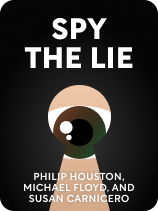

This article is an excerpt from the Shortform book guide to "Spy the Lie" by Philip Houston, Michael Floyd, and Susan Carnicero. Shortform has the world's best summaries and analyses of books you should be reading.
Like this article? Sign up for a free trial here.
What is the Spy the Lie book about? What can we learn from the CIA about lie detection?
In Spy the Lie, a book written by former CIA and NSA professionals, the authors explain their system for asking questions and watching responses in an interrogation. Their system can be used in many contexts, both in an interrogation and in daily life.
Continue reading to learn how to spot a lie according to the experts.
About the Book Spy the Lie
Have you ever had the feeling someone was lying to you…even when every word from their mouth seemed true? In a world where truth and lies seem always to be intertwined, the Spy the Lie book gives you the tools to cut through distracting and misleading details—with effective questions and a sharp eye for suspicious “tells,” you’ll know when someone is trying to deceive you or hide the truth.
In this book, CIA veterans Philip Houston, Michael Floyd, and Susan Carnicero, and former NSA analyst Don Tennant, describe their system for interviewing informants, suspects, and applicants for sensitive positions—and they explain how the system can help anyone detect deception.
The System: A Tool for Spotting Hidden Deception
Since deception often hides within truth—and you’re biased to expect people will be honest—you can’t rely on mere intuition to know when someone’s lying to you. This is why the authors devised the System: a process that enables you to ignore distracting and misleading truthful statements and only focus on whether someone is sending signals that they’re lying. This guide will cover how to use the System in three parts:
- The Basics of the System discusses how the System was created and its essential elements.
- Step 1: Ask Your Interviewee Questions explores the types of questions that are most effective for getting someone to reveal deception.
- Step 2: Listen and Watch For Signs of Deception describes the telltale verbal and behavioral signs of deception to look out for.
The Basics of the System
In his CIA career, Houston interviewed people using a polygraph machine, a device that charts a person’s physiological responses to questions. As Houston gradually learned which verbal and behavioral signals reliably linked to deceptive responses, he created a System to replicate the polygraph’s functionality in two steps:
- Ask someone (we’ll call him the “interviewee”) a question. This stimulus prompts the interviewee’s verbal response and involuntary physical reactions.
- Watch and listen closely to your interviewee’s reactions and responses. You’ll look for elements of their response that suggest they might be deceiving you or having a physiological reaction to your question. (We’ll cover telltale verbal and behavioral signs of deception in the final section of the guide.)
The Key to the System’s Success: The Five-Second Rule
The authors stress that human brains simply cannot process and analyze each word and behavior in a conversation. The System gets around this shortcoming by implementing the five-second rule: Instead of trying to interpret the meaning of everything the interviewee says or does, you’ll watch and listen for signals of deception only in the first five seconds following each question.
This rule has two main benefits: First, closely observing the period immediately following your question tells you whether your interviewee’s actions are direct reactions to what you asked. In other words, if you see a sign of deception within five seconds of asking your question, you can assume your question triggered it. However, if you see a potentially suspicious sign outside of this timeframe, you can likely disregard it.
Watch for Clusters
Once you notice a sign of deception within those crucial five seconds, the authors instruct you to pay attention to whether it forms a cluster. A cluster is when the interviewee shows two or more signs of deception in their response. The first sign must happen within the first five seconds following your question, and the further signs of deception can happen at any time in the response, up until the interviewee is interrupted by another stimulus. (Shortform note: Though the authors don’t define what “interruption” means, we can infer that it refers to any event, including another question, that draws the interviewee’s attention away from you.)
Step 1: Ask Your Interviewee Questions
Now that you understand the basics of the System, let’s explore the details of using it. The first step is to ask the interviewee a question—creating a stimulus that they’ll have to react to. In this section, we’ll first cover the most effective methods of questioning, then explain behaviors to avoid when asking questions.
Ask the Right Questions
The authors advise that certain types of questions are more effective than others. The “right” kinds of questions conserve your mental energy—saving it for the intense focus required in observing both the verbal and behavioral aspects of your interviewee’s response. Effective questions also increase the mental energy your interviewee must spend on his responses—making it harder for him to create false details, keep his story straight, and figure out ways to get around directly answering you.
The authors discuss three traits of effective questions: They’re relevant, they’re short, and they’re loaded. Let’s explore each trait in detail.
Trait #1: They’re Relevant to Your Goal
The authors explain that if you’re using the System in a conversation with someone, you’re likely trying to determine whether they’re telling the truth about something specific. To save your mental energy, only ask questions that pursue the goal of obtaining this specific information.
Trait #2: They’re as Short as Possible
By asking brief questions, you encourage the interviewee to respond quickly and instinctively—often leading to slips or inconsistencies in their story that might indicate a lie. On the other hand, if you ask long questions that give the interviewee time to think while you’re speaking, she can more easily create false details to fit her existing narrative.
Trait #3: They’re Loaded, Not Leading
Leading questions imply one possible, simple answer—usually “yes” or “no.” On the other hand, loaded questions imply that you know some information about the interviewee and what his response should be. This causes your interviewee to spend a lot of mental effort on trying to figure out how much, and what kind of, information you know and carefully deciding on an answer that won’t conflict with that information.
Step 2: Listen and Watch For Signs of Deception
Following each question, you’ll apply the second part of the System: simultaneously watching and listening for verbal and behavioral signs of deception in your interviewee’s response. Recall that the first sign must happen within five seconds of your question, and that you’re looking for a cluster: two or more signs.
Verbal Signs of Deception
The authors provide four broad categories of verbal signs to look out for: “inappropriate” responses, failure or reluctance to answer, qualifier-heavy answers, and generally suspicious responses.
Verbal Category 1: “Inappropriate” Responses
Inappropriate responses don’t make sense given the tone or subject of your conversation. The authors outline four types of inappropriate responses.
Inappropriate questions are ones the interviewee would be unlikely to ask if they were innocent—for example, “What evidence do you have against me?” An innocent interviewee would assume there’s no evidence against him, so he’d be unlikely to ask this question.
Inappropriate levels of politeness: If the interviewee becomes overly formal with you or offers you a compliment for seemingly no reason, he may be trying to be more likable. According to the authors, this is often intended to make you less confrontational and more likely to believe him.
Inappropriately high concern for minor events: For example, the interviewee shows outrage over a coworker’s dessert being stolen from the community fridge. This is often an attempt to portray himself as a righteous, innocent person.
Inappropriately low concern for major events: For example, the interviewee shows indifference or dismissiveness toward a coworker’s murder. By doing this, the interviewee may be trying to convince you that a legitimate problem isn’t actually concerning. The authors describe this as an irrational, defensive effort to escape reality.
Verbal Category 2: Failure or Reluctance to Answer
The authors explain that the interviewee may also try to avoid directly answering you. Let’s examine five strategies the interviewee may use to dodge your questioning.
Complaints about procedure: Comments such as, “This is taking forever!” or “Why are you even talking to me about this?” can seek to convince you that you’re wasting your time talking to the interviewee and should look elsewhere.
Selective memory or understanding: An interviewee’s claim not to understand a question or remember a past event may signal that they’re feigning ignorance. This may be an attempt to frustrate you or convince you to move on in the conversation.
Too-specific answers only give information related to part of your question—deliberately missing its objective. For example, if you ask a potential hire, “What’s your experience overcoming project management challenges?” and the interviewee says, “I’ve managed successful projects before,” you’re dealing with a too-specific answer. The interviewee may be focusing on the specific detail of his projects’ success to hide his poor track record in handling management challenges.
Repeating information: The authors explain that repetition with the intent to deceive can take two different forms:
- The interviewee claims they’ve already answered your question, so they don’t need to answer again. This may be an attempt to avoid the discomfort of directly lying again.
- The interviewee repeats your question back to you. For example, they might respond to your question “Where were you last night?” with “Where was I last night? Let’s see…” The authors say this may be a strategy to buy time.
Nonanswers: When the interviewee starts his response with phrases unrelated to your question—such as, “Funny you should mention that,” or “Great question”—he may be buying time to think about his response.
Verbal Category 3: Qualifier-Heavy Answers
Qualifier-heavy answers use language that makes a statement of facts sound more certain or less certain—depending on whether the interviewee’s objective is to emphasize their trustworthiness or keep their assertions vague.
Emphasizing trustworthiness: When the interviewee uses language like “to be honest” and “to tell the truth,” they try to make a statement appear more certain. This highlights their credibility and buys time for the interviewee to think.
Making vague assertions: The authors say language like “more or less,” “basically,” or “by and large” tries to make a statement of fact less certain. This allows the interviewee to exclude important information to create a quasi-truthful response that doesn’t admit guilt.
Verbal Category 4: Generally Suspicious Responses
The authors explain that some types of responses are simply “suspicious.” Here, we’ll go over five types of responses the authors find generally suspicious and what each suggests about your interviewee’s intentions.
Short denials buried in long explanations: Remember that creating complete fabrications can be psychologically difficult. The authors say that because of this mental barrier, a long explanation with only a brief denial inside it can signify the interviewee’s discomfort with their denial. To cushion this discomfort, they add information that may have little to do with the denial itself.
Inconsistent responses, which make a different statement of fact from a previous response, suggest the interviewee fabricated at least one of them.
Ambiguous denials are claims of innocence like, “I didn’t do anything wrong!” which don’t directly address your question. The authors explain this often signals a desire to avoid committing to an outright fabrication.
Aggressive or condescending responses are often an attempt to scare or annoy you into backing off your line of questioning.
Making oaths: The authors say an interviewee who swears on God may be both trying to look pious and hoping you’ll accept their earnestness.
Behavioral Signs of Deception
Alongside verbal signs of deception, the authors suggest watching for behavioral signs: things people do in response to your questions. These include: pauses before answering, suspicious body language, and disconnects between speech and action. As with verbal signs, we can divide these behavioral categories into subcategories, each of which counts as one sign of deception. Let’s cover each category now.
Behavioral Category 1: Pauses Before Answering
People commonly pause before answering a question. According to the authors, you must decide within the context of the conversation whether a pause is “too long.”
Some questions merit a pause—for example, “Where were you a month ago?”—because most people can’t remember details off the top of their head. Meanwhile, a question like, “Did you steal that gun?” warrants an immediate answer, because no honest person would need to think about the response.
Behavioral Category 2: Suspicious Body Language
Body language often subconsciously betrays someone’s true emotions by flagging sudden increases in anxiety. In the authors’ experience, the following kinds of body language reliably serve this purpose. We’ll explain each one, as well as any caveats you should keep in mind.
Shifting in place: The more pronounced the movement and the closer it occurs to your question, the more suspicious it is. The authors say it’s important to pay attention to when the movement happens: If the interviewee slides his chair forward for the first time immediately after your question, it suggests deception. On the other hand, if he slides around consistently, not as a response to your question, it may not be a sign of deception.
Throat clearing before answering, not after: Throat clearing signals both anxiety and an attempt to buy time. However, if it comes at the end of your interviewee’s response, it’s much more likely to be a natural bodily function.
Spikes in fidgeting or grooming often accompany anxiety. Examples include playing with hair, picking at fingernails, clicking a pen, clenching hands, and similar actions.
Hiding the face, especially the eyes or mouth, is a natural indication of shame or embarrassment—two emotions people commonly feel when lying.
Behavioral Category 3: Disconnects Between Speech and Action
The authors say the brain automatically matches verbal and behavioral actions to each other, and it’s difficult to act against this tendency. For example, an innocent interviewee should shake her head, not nod, when denying your accusation. On the other hand, nodding while saying, “I didn’t do it,” is a sign of deception.
This doesn’t apply to brief answers where any head motion could be punctuative, such as an emphatic nod alongside a simple, “No!” Additionally, the authors note that knowing your interviewee’s background is important: In some cultures, nodding means “no” while shaking your head means “yes.”
Exercise: Examine Your Biases and Prepare to Use the System
The authors assert that everyone is capable of deception. To get comfortable testing others for signs of deception, you must first rid yourself of the belief that someone else would never lie to you. In this exercise, reflect on why you might trust others by default and why you may need to use the System.
- Identify a situation where you might instinctively trust a stranger. Why are you inclined to do this?
- Are there any people you trust so much that you’d never suspect them of lying? Who are they, and why do you believe they’d never deceive you?
- Describe one reason why it may be wise to use the System to verify what someone tells you, even though you trust them. For example, the other person might be ashamed of something they’ve done wrong, so they’re lying to avoid damaging your relationship.

———End of Preview———
Like what you just read? Read the rest of the world's best book summary and analysis of Philip Houston, Michael Floyd, and Susan Carnicero's "Spy the Lie" at Shortform.
Here's what you'll find in our full Spy the Lie summary:
- Why your brain is wired to believe others
- How you can learn to read body language like a spy
- The three traits of effective lie-detecting questions






